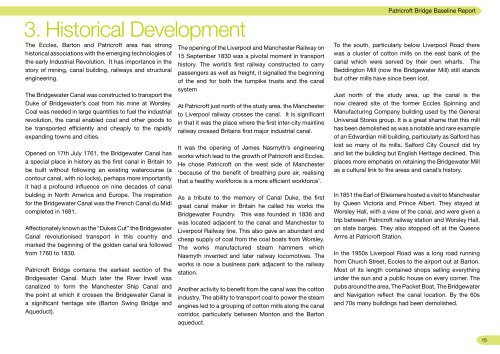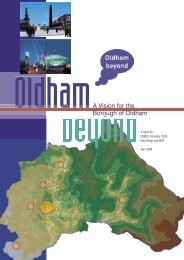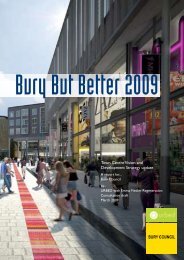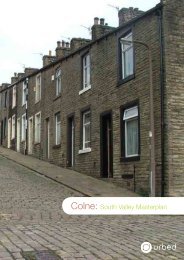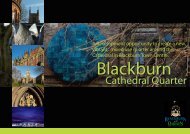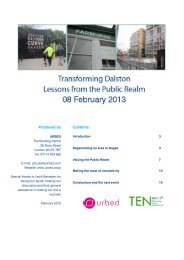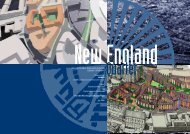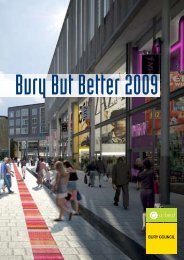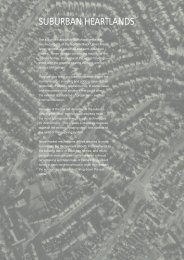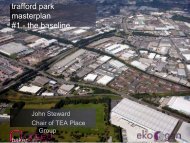Patricroft Bridge Baseline Report.pdf - Urbed
Patricroft Bridge Baseline Report.pdf - Urbed
Patricroft Bridge Baseline Report.pdf - Urbed
Create successful ePaper yourself
Turn your PDF publications into a flip-book with our unique Google optimized e-Paper software.
3. Historical DevelopmentThe Eccles, Barton and <strong>Patricroft</strong> area has stronghistorical associations with the emerging technologies ofthe early Industrial Revolution. It has importance in thestory of mining, canal building, railways and structuralengineering.The <strong>Bridge</strong>water Canal was constructed to transport theDuke of <strong>Bridge</strong>water’s coal from his mine at Worsley.Coal was needed in large quantities to fuel the industrialrevolution, the canal enabled coal and other goods tobe transported efficiently and cheaply to the rapidlyexpanding towns and cities.Opened on 17th July 1761, the <strong>Bridge</strong>water Canal hasa special place in history as the first canal in Britain tobe built without following an existing watercourse (acontour canal, with no locks), perhaps more importantlyit had a profound influence on nine decades of canalbulding in North America and Europe. The inspirationfor the <strong>Bridge</strong>water Canal was the French Canal du Midicompleted in 1681.Affectionately known as the “Dukes Cut” the <strong>Bridge</strong>waterCanal revolutionised transport in this country andmarked the beginning of the golden canal era followedfrom 1760 to 1830.<strong>Patricroft</strong> <strong>Bridge</strong> contains the earliest section of the<strong>Bridge</strong>water Canal. Much later the River Irwell wascanalized to form the Manchester Ship Canal andthe point at which it crosses the <strong>Bridge</strong>water Canal isa significant heritage site (Barton Swing <strong>Bridge</strong> andAqueduct).The opening of the Liverpool and Manchester Railway on15 September 1830 was a pivotal moment in transporthistory. The world’s first railway constructed to carrypassengers as well as freight, it signalled the beginningof the end for both the turnpike trusts and the canalsystemAt <strong>Patricroft</strong> just north of the study area, the Manchesterto Liverpool railway crosses the canal. It is significantin that it was the place where the first inter-city mainlinerailway crossed Britains first major industrial canal.It was the opening of James Nasmyth’s engineeringworks which lead to the growth of <strong>Patricroft</strong> and Eccles.He chose <strong>Patricroft</strong> on the west side of Manchester‘because of the benefit of breathing pure air, realisingthat a healthy workforce is a more efficient workforce’.As a tribute to the memory of Canal Duke, the firstgreat canal maker in Britain he called his works the<strong>Bridge</strong>water Foundry. This was founded in 1836 andwas located adjacent to the canal and Manchester toLiverpool Railway line. This also gave an abundant andcheap supply of coal from the coal boats from Worsley.The works manufactured steam hammers whichNasmyth invented and later railway locomotives. Theworks is now a business park adjacent to the railwaystation.Another activity to benefit from the canal was the cottonindustry. The ability to transport coal to power the steamengines led to a grouping of cotton mills along the canalcorridor, particularly between Monton and the Bartonaqueduct.<strong>Patricroft</strong> <strong>Bridge</strong> <strong>Baseline</strong> <strong>Report</strong>To the south, particularly below Liverpool Road therewas a cluster of cotton mills on the east bank of thecanal which were served by their own wharfs. TheBeddington Mill (now the <strong>Bridge</strong>water Mill) still standsbut other mills have since been lost.Just north of the study area, up the canal is thenow cleared site of the former Eccles Spinning andManufacturing Company building used by the GeneralUniversal Stores group. It is a great shame that this millhas been demolished as was a notable and rare exampleof an Edwardian mill building, particularly as Salford haslost so many of its mills. Salford City Council did tryand list the building but English Heritage declined. Thisplaces more emphasis on retaining the <strong>Bridge</strong>water Millas a cultural link to the areas and canal’s history.In 1851 the Earl of Ellesmere hosted a visit to Manchesterby Queen Victoria and Prince Albert. They stayed atWorsley Hall, with a view of the canal, and were given atrip between <strong>Patricroft</strong> railway station and Worsley Hall,on state barges. They also stopped off at the QueensArms at <strong>Patricroft</strong> Station.In the 1950s Liverpool Road was a long road runningfrom Church Street, Eccles to the airport out at Barton.Most of its length contained shops selling everythingunder the sun and a public house on every corner. Thepubs around the area, The Packet Boat, The <strong>Bridge</strong>waterand Navigation reflect the canal location. By the 60sand 70s many buildings had been demolished.15


